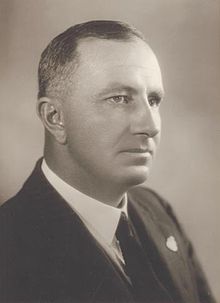- Charles Hawker
-
The Honourable
Charles Hawker
Member of the Australian Parliament
for WakefieldIn office
12 October 1929 – 25 October 1938Preceded by Maurice Collins Succeeded by Sydney McHugh Personal details Born 16 May 1894
Clare, South AustraliaDied 25 October 1938 (aged 44)
Mount Dandenong, VictoriaNationality Australian Political party Nationalist (1929–31)
UAP (1931–38)Alma mater Cambridge University Occupation Soldier Charles Allan Seymour Hawker (16 May 1894 – 25 October 1938) was an Australian politician.
Hawker was born near Clare, South Australia and educated at Geelong Grammar School, Hawker and Trinity College, Cambridge, earning Bachelor and Master of Arts degrees in 1919 and 1922 respectively. While at Cambridge he enlisted in the British Army to serve in World War I. Fighting in the Battle of Passchendaele, Hawker was injured and left severely handicapped.[1][2]
Hawker returned to Australia in 1920 and in 1929 was elected as a member of the Australian House of Representatives, representing the electorate of Wakefield for the United Australia Party. He was appointed Minister for Markets and Minister for Repatriation in first ministry of Prime Minister Joseph Lyons and was the youngest member of the ministry. On 12 April 1932 he was replaced as Minister for Repatriation by Charles Marr and the Markets portfolio was renamed Commerce. On 23 September 1932, he resigned from the ministry in protest at its refusal to reduce parliamentary salaries in response to the Great Depression and did not serve as a minister again.[2]
Hawker died in a plane crash near Mount Dandenong, Victoria in 1938.[3] The Australian Electoral Division of Hawker and the Canberra suburb of Hawker, Australian Capital Territory are named in his honour, and the Charles Allan Seymour Hawker Scholarship was established by his sister Kathleen Lilias Needham in 1991 to fund Australian university education.[4] His relative David Hawker is a former Speaker of the Australian House of Representatives.
References
- ^ "The Charles Hawker Story". The Charles Allan Seymour Hawker Scholarship. http://www.hawkerscholarship.org/charleshawker.html. Retrieved 12 January 2008.
- ^ a b Van Dissel, Dirk (1983). "Hawker, Charles Allan Seymour (1894–1938)". Australian Dictionary of Biography. Canberra: Australian National University. http://www.adb.online.anu.edu.au/biogs/A090234b.htm. Retrieved 12 January 2008.
- ^ "The crash of Kyeema" (PDF). Civil Aviation Safety Authority. 2006. http://www.casa.gov.au/fsa/1998/nov/kyeema.pdf. Retrieved 12 January 2008.
- ^ "History of the Charles Allan Seymour Hawker Scholarship Trust Fund". Charles Allan Seymour Hawker Scholarship. http://www.hawkerscholarship.org. Retrieved 12 January 2008.
Political offices Preceded by
Parker MoloneyMinister for Markets
Minister for Commerce
1932Succeeded by
Joseph LyonsPreceded by
John McNeillMinister for Repatriation
1932Succeeded by
Charles MarrParliament of Australia Preceded by
Maurice CollinsMember for Wakefield
1929–38Succeeded by
Sydney McHughCategories:- 1894 births
- 1938 deaths
- Members of the Australian House of Representatives for Wakefield
- Members of the Australian House of Representatives
- Members of the Cabinet of Australia
- People educated at Geelong Grammar School
- United Australia Party politicians
- Alumni of Trinity College, Cambridge
- Australian military personnel of World War I
- Victims of aviation accidents or incidents in Australia
- Accidental deaths in Victoria (Australia)
- Jubilee 150 Walkway
Wikimedia Foundation. 2010.
